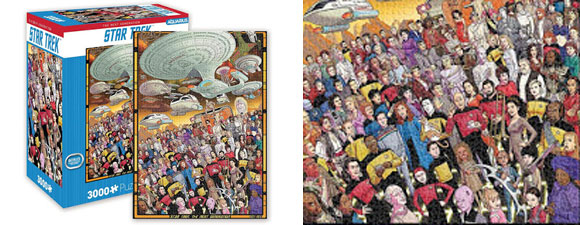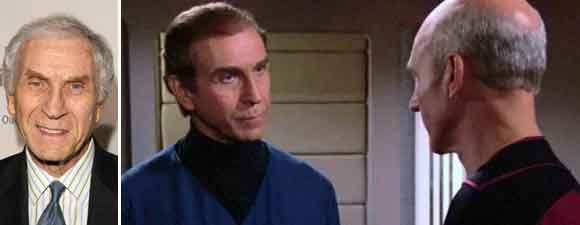Retro Review: Emergence
5 min readWhen the Enterprise begins to develop intelligence of its own, crewmembers use the holodeck to try to decipher the sudden system changes.
Plot Summary: While Data is rehearsing The Tempest on the holodeck, a freight train suddenly runs through the program, injuring Picard. Not long after, the ship goes into warp and changes course without a command from the helm. When LaForge investigates, he finds that the ship has begun to create nodes of new circuitry protected by force fields. The nodes appear to be drawing power from the holodeck, so Riker takes Data and Worf to investigate. They find several different programs running, all centered around Crusher’s Orient Express scenario. When Data tries to depolarize the power grid, various Wild West and mobster characters demand that he stop, and the conductor throws the Enterprise crewmembers off the train. Meanwhile, the ship goes into warp again and LaForge discovers that the ship appears to be building something inside one of the cargo bays. The new nodes resemble the circuits in Data’s positronic brain, so Data theorizes that the Enterprise may be developing its own intelligence, and that the holodeck characters might represent different systems of the ship. He returns to the holodeck with Troi and Worf, who find a recurrent pattern that LaForge has also discovered in the shape of the new circuitry. The object being constructed in the cargo bay has the same pattern as well. When Troi and Worf offer to help the characters on the holodeck reach their destination, they are told that the ship must reach Vertiform City. With the crew’s help, Picard realizes that the ship requires vertion particles to finish its task and allows the Enterprise to travel to a white dwarf star producing the particles. But on the holodeck, the train derails and the characters panic. Since the emerging intelligence apparently requires vertion particles, LaForge finds a nebula where the crew detonates a photon torpedo to generate the particles. The holodeck characters announce that the train has reached New Vertiform City and disappear; meanwhile, the object in the cargo bay, which is apparently a new intelligent being, travels through the bulkheads and out into space. The new circuitry disappears and Picard expresses hope that if the Enterprise has created a life form from the sum total of the ship and crew’s experiences, it will reflect the honor of the Enterprise’s mission.
Analysis: If that plot summary above makes no sense, don’t blame me. “Emergence” is nearly as convoluted and preposterous as “Masks,” and I still have no idea whether the magnetic storm the ship encounters in the first minutes of the episode is supposed to be responsible for its abrupt decision to have a baby or whether – since the freight train had already come through the holodeck before the bridge crew discovered the storm – the ship’s desire to reproduce emerged as spontaneously as the circuits that surprisingly don’t seem to panic anyone, not even when the crew figures out that the ship may be planning to exhaust their life support and kill them all in its efforts to reach “New Vertiform City.” In a way I suppose this is the logical sequel to “The Quality of Life” – the episode in which Data was willing to risk human lives in order to save the exocomps, which no one was actually certain were intelligent life forms – but there are no explicit connections drawn, so there’s really no sense that the writers had any idea better than doing some huge goofy holodeck smorgasbord in the final weeks of production on Star Trek: The Next Generation. The only thing this one is missing is Reg Barclay.
Captain Kirk always claimed that his Enterprise was a beautiful lady with a mind of her own, and “Emergence” seems to take that idea a bit too seriously. It’s rather charming when it becomes obvious that the train’s conductor, engineer, et al represent aspects of the Enterprise, but when the crew then insists on explicating that for the audience – and when Crusher says that the replicators are like a reproductive system, which is stretching an already thin idea to the breaking point – it just sounds ridiculous. The fact that the ship’s manufactured intelligence takes the form of giant Silly Straws doesn’t help matters. And do I want to know which ship’s systems are represented by the holographic ladies of the night? I suppose it’s a saving grace that the crew seems more amused than alarmed at having stock characters on the holodeck running their lives, since an overly earnest Picard barking commands would just trigger more snickering. If Picard is hoping the ship has absorbed his crew’s values and goals, he must be disappointed that it absorbed so little imagination. Its personified systems have none of the wonder of Shakespeare’s characters from The Tempest, nor even the wit that one imagines Crusher’s holographic Sigmund Freud and Gertrude Stein might have shared, and where is Moriarty when an intelligent explanation is needed? Fans of pulp fiction and genre movies will probably appreciate the holo-stereotypes, but I’ll take “A Fistful of Datas” over this.
Nice aspects include a good balance of the entire ensemble cast (including some lovely throwaway moments like Worf shoveling coal on the train and Troi following a mobster through a holographic version of historic New York City). Poor LaForge gets stuck with most of the technobabble, which seems unfair since Data has a balance of fake science and timeless Shakespeare. I wish some of the excess plot had been dispensed with – the fear that the ship is trying to kill them to get vertion particles, the stop-and-start warp drive – to save time for some discussion of what it all means. This episode could tie into all the stories about whether Data is “alive,” how intelligence is defined, the limits of Moriarty’s defiant “Cogito Ergo Sum” (and does the crew now have an obligation to release his intelligence from his prison-cube?). It could also raise a whole host of questions for future Star Trek series about shipboard artificial intelligences. If Daystrom’s M5 demonstrates the dangerous negative aspect of trying to build a ship that can think for itself, with the Borg representing the extreme development of that technology, then isn’t the Enterprise’s evolution the positive alternative, the first step toward the spiritual breakthrough of V’ger? Picard has never much shared Kirk’s impulse toward anthropomorphism of his ship, but Picard is the one with a sentient android on his crew – the possibility of an intelligent ship is that much closer for him. Wouldn’t he be a bit more curious about what made his ship create an intelligence…and then send it out unsupervised into the universe, mission unknown?






